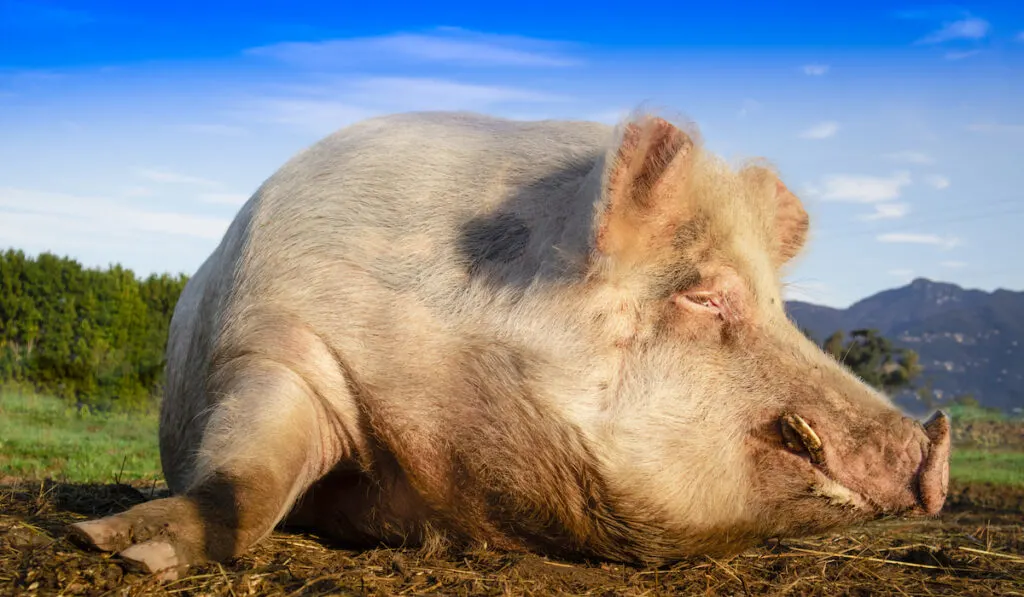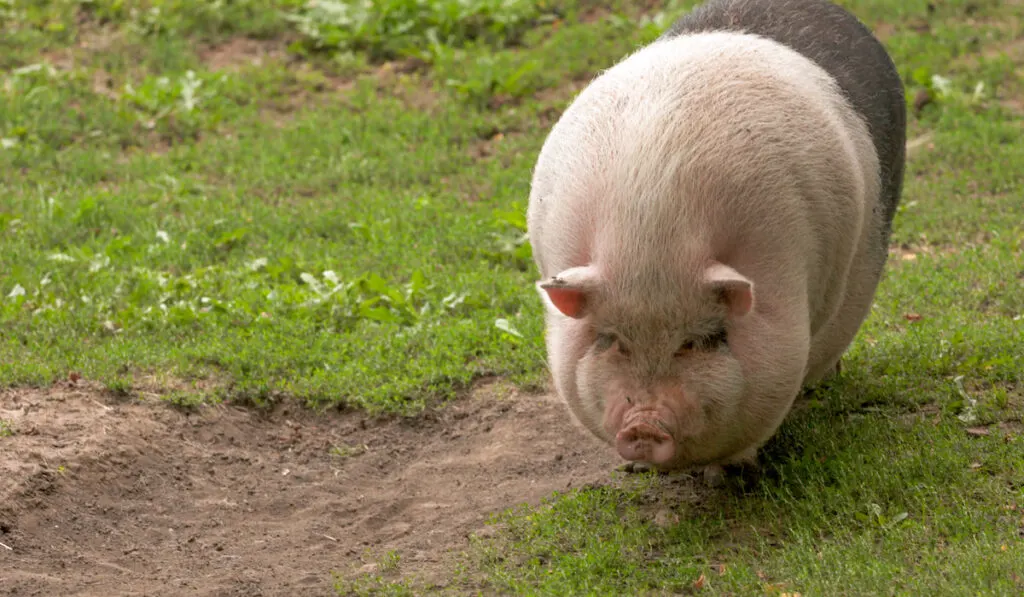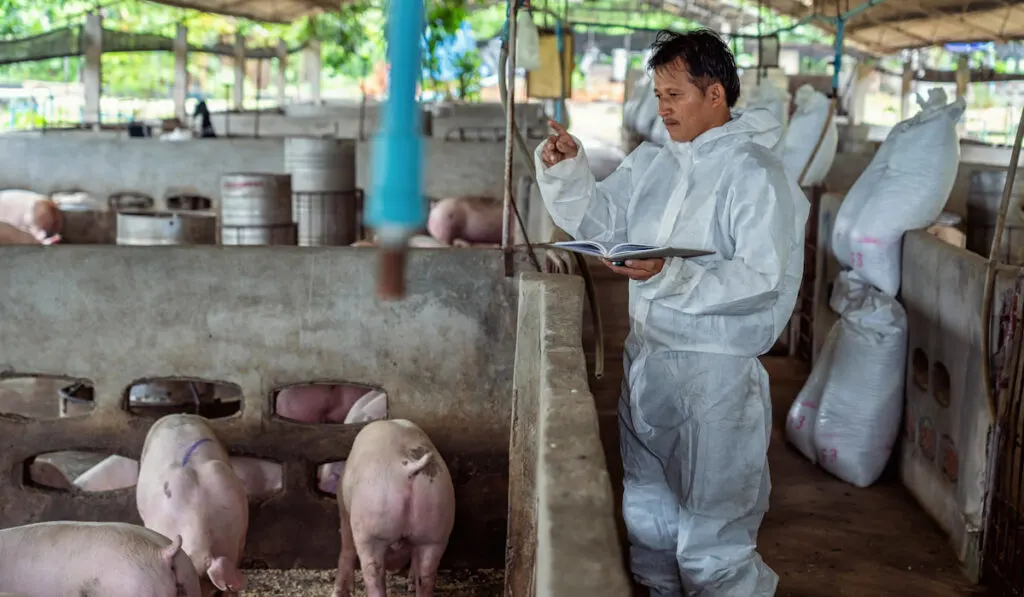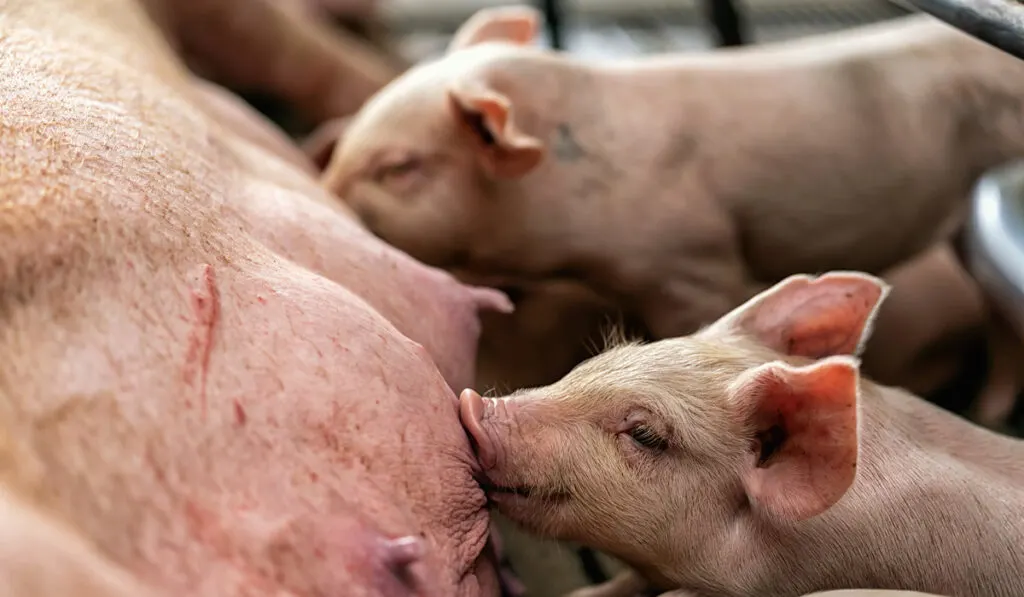Pigs are easy to care for with the right housing, feeding, and handling.
With time, you may notice that your pig has a different temperament and experiences physical changes during different times in its life. One of those times is breeding season. Being a first-time pig farmer can be confusing, as you may not know what signs of pig pregnancy to look out for.
Fortunately, you don’t have to go through expensive tests to determine if you have a pregnant pig. Our detailed guide covers some of the common signs of pregnancy in pigs. Understanding these signs will help you know how to act around your pig, what to feed her, and the kind of housing she may need.
Table of Contents
6 Signs of a Pregnant Pig
Some of the signs to watch out for include:
1. Changes in the Estrous Cycle

The estrous cycle takes 21 days. That gives you enough time to attempt breeding after a few weeks when the pig goes into heat. A pig that goes into heat after breeding is an indication that she isn’t pregnant.
Pigs have a high pregnancy success rate. That fact, combined with the short estrous cycle, shows that you don’t have to wait long before a pig gets pregnant. Some of the signs of heat include a swollen vulva, erect ears, discharge, and an increased interest in boars.
If your pig is no longer in heat and shows no interest in mating, that shows the insemination or mating process was successful. The sow will want to stay away from males, and she won’t go back into estrous.
For a pig that hasn’t entered the estrous cycle for 17-21 days after being bred, there’s a high chance of her being pregnant.
2. Weight Gain

Weight gain is the only noticeable sign of pregnancy for the first 100 days. Experienced farmers can detect this change 30 days from farrowing (giving birth).
Although a pregnant pig doesn’t gain as much weight, you may notice some changes in her appetite. She may appear heavier than normal. Over time, her belly might appear asymmetrical and swollen, but you’ll need to check carefully to see this.
Her teats can also appear swollen as they begin to fill with milk. This process starts with the rear teats and progresses forward to the front teats.
Note that older sows might not experience the swelling until two to three weeks before farrowing. It’s easy to tell: You can expect piglets soon if one of the teats expresses milk.
3. Increase in Appetite

In the early stages of a pig’s pregnancy, you’ll notice an increased appetite. However, for the last weeks of pregnancy, her appetite will be even greater as her body doesn’t produce fat, and the available fat is turned into milk for the young ones.
Although you should increase the sow’s feed throughout her pregnancy, it’s essential to increase her feed over the last few weeks. Her diet should be balanced and have plenty of vegetables and fruits.
4. Behavioral Changes
A pregnant sow won’t be interested in any advances from male pigs and will lose any sexual interest, like making gestures or producing courtship-related sounds.
You’ll also notice that a pig becomes restless a few days before farrowing. (Farrowing is the period before the piglets are born.) The pig will exhibit signs of discomfort and may make whining noises. She may isolate herself from others.
The sow may also find a suitable farrowing place and may start collecting and arranging material for her nest. She will use her mouth to gather dry straw. You can help your pig’s birthing preparations by placing clean, fresh straw in the birthing shelter.
When a pig is ready to give birth, she lies down and stops all activities.
A pregnant pig may also become aggressive or overly friendly. Sometimes she’ll want attention or may choose to isolate herself. Additionally, she can decide to rest more or become active. If you notice these behavioral changes in your pig, she may be pregnant.
5. Changes in the Appearance of the Vulva
It’s possible to tell if your pig is pregnant by checking her vulva.
A pregnant sow’s abdomen hangs closer to the ground due to the heavy piglets. That causes swelling to the reproductive parts, causing the vulva to tilt upward.
While this may not be visible in all pigs, it’s a sign to watch out if you are raising pigs.
6. Changes in the Heartbeat

Your sow’s heartbeat changes when she’s pregnant. Commercial breeders measure gestation using a pig’s heartbeat, and you can use this method to determine if your pig is pregnant.
However, if you don’t monitor your pig’s vital signs, you may find the heartbeat change difficult to detect. A veterinarian can also help check for changes in heartbeat and can also detect the piglets’ heartbeats.
Is There Another Way to Tell if Your Pig Is Pregnant?
Apart from checking for the above signs, you can also use ultrasound to determine if your pig is pregnant. Ultrasound machines like doppler, amplitude depth, and real-time are used in the swine industry. Pregnancy is determined by the interpretation of sound patterns, light, or pictures.
An ultrasound can be carried out by an experienced veterinarian. Although this method isn’t economical for a lot of pig breeders, it can help confirm pregnancy if you are a small-scale farmer. This method can detect pregnancy 30-80 days from conception.
A vet can also perform rectal palpation, where he/she checks the size, fremitus (vibration), and position of the medial uterine artery. A veterinarian can also check the tension/tone of the cervix together with the contents of the uterus to determine if a pig is pregnant.

Determining Your Pig’s Gestation Period
A pig is pregnant for three months, three weeks, and three days.
Pigs get pregnant quickly and can start exhibiting signs of pregnancy a few weeks into gestation. That corresponds to a cessation of the estrous cycle. When the estrous cycle ends, the pig won’t go into heat after 21 days.
That means if you know the mating date, you can plan on the farrowing date, which is about 114 days after the mating date.
You need to have records of when your sow was bred to determine the farrowing date to be prepared for piglets.

Can Illness Mimic Breeding Success?
You should note that some pig illnesses can resemble pregnancy symptoms.
In certain cases, a swollen belly can indicate a swine illness. Conditions like intestinal torsion, porcine enteropathy, and lymphosarcoma manifest in the form of a bloated belly.
Rectal or cervical prolapse can lead to changes in the clitoris.
If you are a new pig owner and aren’t sure whether your pig is pregnant or not, it’s best to call a veterinarian.
Final Thoughts
You can easily tell your pig is pregnant by checking whether it goes into heat (based on its estimated cycle), checking its teats/vulva, observing any behavior change, and noting a lack of interest in mating.
Alternatively, a vet can confirm pregnancy, or you can use pregnancy test strips. Note that certain signs will present themselves after some weeks of mating, while others will only be evident when the pig is about to give birth.
Remember that although the breeding process may fail at one point, you can still wait for a few more weeks and try again, as pigs have a high success rate in getting pregnant.
